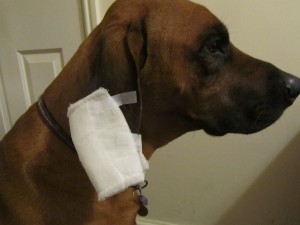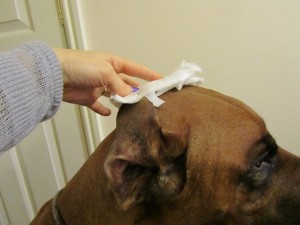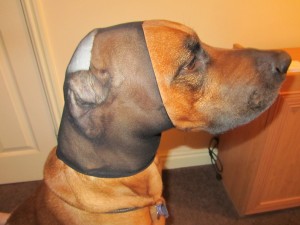Bleeding Ear Tips – This morning while on our walk I was wondering what I would put in today’s blog. Axl, my trustee Rhodesian Ridgeback side-kick, must have been reading my thoughts because no sooner had the thought crossed my mind, than he came up with the answer for me. Now that he’s an “agility nut”, he loves to leap and jump over as many fences as possible and this morning was no exception. He charged at a fence but didn’t realise that above it ran a length of wire, tacked to the top rung. Thankfully it was not barbed wire, but there was a sharp point sticking out none the less.
Now don’t ask me how he managed it, but after he’d jumped the fence he’d put a tiny nick in his right ear tip and therefore, today’s blog is about bandaging the more tricky bits of your wriggly canine!
As you know, when dealing with bleeding we always employ the S.E.E.P. checklist so that we get everything in the right order and don’t miss any steps out:
S = Sit or Lie (which ever position allows the bleeding bit to be elevated)
E = Elevate (raise the wound to slow down the bleed)
E = Examine (check what type of bleed you have & if there is anything stuck in it)
P = Pressure (Applied directly to the wound itself so long as nothing is protruding)
Now usually, with most body parts this would be easy enough, but with Axl’s long floppy ears, its a little more tricky to elevate them – so here’s how we treat a split ear tip.
1) Apply a wound dressing over the ear tip and hold firmly in place with microporous tape

2) Fold the ear so that it lies across the top of the dog’s head

3) Hold the ear in place on top of the head with the leg of a pair of tights, like a snood.
(When using a pair of tights, please make sure you select a size big enough for the breed of dog you have. There is no point in using “petite” stockings on a Ridgeback as they would be too tight and be both uncomfortable and restrictive for his breathing/swallowing. Ridgebacks definitely require a “large” or “extra large” size of stockings/tights. The ones used in the picture for demonstration purposes are only “small” and as you can see, they are a little tight under his lower jaw/neck, so please do get the correct size for your breed.)
Leave the ear and dressing in place like this for at least 5 minutes to give the blood time to clot.

4) Remove the dressing and replace the ear into its normal position and then re-apply the stocking to keep the ear pressed to the side of the head to prevent re-opening if the dog should flap his head (at least 60 minutes).

A small split in the ear tip should be controlled fairly well using this method – you’ll need to keep the stocking in place for an hour or so.
If the ear refuses to heal, you can of course opt for a veterinary glue to “stick” the wound together. There are several on the market that are recommended for veterinary use only. The monomeric formulation forms a thin, waterproof adhesion to bond/seal tissue in a variety of injuries.
- Box contains a twist cap dispensing bottle with five (5) individual applicators
- Ideal for skin closure
- Perfect for veterinary declaw procedures or quick fixes
For a more severe split, it is likely that it may be necessary for your dog to wear his fashionable new look for as much as a week or two, even after the bleeding has stopped, to prevent the split re-opening again. Make sure the split is really nicely healed before you allow him to stop wearing the stocking (and before you say it, yes, I know he looks like the saddest dog in all the world in these pictures but I’m happy to report that all was well within 30 minutes).



